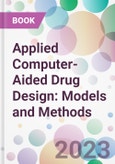Key Features
- Presents the concepts and evolution of classical techniques, up to the use of modern methods based on computational chemistry in accessible format.
- Gives a primer on structure- and ligand-based drug design and their predictive capacity to discover new drugs.
- Explains theoretical fundamentals and applications of computer-aided drug design.
- Focuses on a range of applications of the computations tools, such as molecular docking; molecular dynamics simulations; homology modeling, pharmacophore modeling, quantitative structure-activity relationships (QSAR), density functional theory (DFT), fragment-based drug design (FBDD), and free energy perturbation (FEP).
- Includes scientific reference for advanced readers
Readership
Students, teachers and early career researchers.Table of Contents
- Contents
- Preface
- References
- List of Contributors
- Promising Approaches to Discover New Drugs
- Igor José Dos Santos Nascimento and Ricardo Olimpio De Moura
- Introduction
- Drug Design and Discovery: Past and Today Methods and Other
- Approaches
- Natural Compounds (Nc)
- Synthetic Drugs: Classical Approaches
- Bioisosterism
- Molecular Simplification
- Molecular Hybridization
- Combinatorial Chemistry
- High Throughput Screening (Hts)
- Target-Based Drug Discovery (Tbdd)
- Phenotypic-Based Drug Discovery (Pbdd)
- Multitarget Drug Design (Mdd)
- Computer-Aided Drug Design (Cadd)
- Sbdd and Lbdd Methods in Drug Design
- Structure-Based Drug Design (Sbdd)
- Homology Modeling
- Molecular Docking and Molecular Dynamics Simulations
- Fragment-Based Drug Design (Fbdd) or De Novo Drug Design
- Density Function Theory (Dft)
- Ligand-Based Drug Design (Lbdd)
- Quantitative Structure-Activity Relationship (Qsar)
- Pharmacophore Modeling
- Machine and Deep Learning and Artificial Methods
- Challenges and Opportunities in Lbdd and Sbdd Approaches To
- Design and Discover New Drugs
- Conclusion
- Acknowledgments
- References
- Studying the Biologically Active Molecules
- Serap Çetinkaya, Burak Tüzün and Emin Saripinar
- Introduction
- Qsar's Use
- Qsar Model Development
- 2D-Qsar Analysis
- Fragment-Based 2D-Qsar Methods
- 3D-Qsar
- 4D-Qsar
- 5D- and 6D-Qsars
- Molecular Modelling and Qsar
- Importance of the Validation of Qsar Models
- Means of Proof for Qsar Models
- Internal Validation
- External Validation
- Easily Reproducible Qsar Protocol
- Conclusion
- References
- Drug Design and Discovery
- Dharmraj V. Pathak, Abha Vyas, Sneha R. Sagar, Hardik G. Bhatt and Paresh K.
- Patel
- Introduction
- Definitions of Pharmacophore
- Pharmacophore: History
- Pharmacophoric Features
- Ligand Based Pharmacophore
- Ligand-Based Pharmacophore Modeling
- Selection of the Right Set of Compounds and Their Initial Structure
- Conformational Search
- Feature Representation and Extraction
- Pattern Identification/Molecular Alignment
- Scoring the Common Pharmacophore
- Pharmacophore Tools and Their Algorithms
- Pharmacophore Validation
- Cost Analysis
- Fisher’S Randomization Test
- Test Set Prediction
- Leave-One-Out Method
- 3D-Qsar
- Pharmacophore Based 3D Qsar
- Structure Based Pharmacophore
- Structure Based Pharmacophore Model Generation
- Active Site Identification
- Complementary Image Construction
- Query Generation, Searching and Hit Analysis
- Validation
- Virtual Screening
- Prefiltering
- Application of Pharmacophore Mapping
- A Successful Example of Pharmacophore-Based Drug Design: An Example of How
- Anthranilamide Derivatives Were Successfully Shown to Be Promising Factor Xa Inhibitors
- [163]
- Applications of Artificial Intelligence in Pharmacophore Mapping
- Limitations of Pharmacophore Modeling
- Conclusion
- Acknowledgements
- References
- Muhammed Tilahun Muhammed and Esin Aki-Yalcin
- Introduction
- Brief History of Homology Modeling
- Homology Modeling Procedure
- Identification and Selection of Templates
- Sequence Alignments and Alignment Correction
- Model Building
- Loop Modeling
- Side-Chain Modeling
- Model Optimization
- Model Evaluation and Validation
- Overview of Homology Modeling Tools
- Modeller
- I-Tasser
- Swiss-Model
- Prime
- Phyre2
- Hhpred
- Rosettacm
- Alpha Fold
- Case Study
- Applications of Homology Modeling in Drug Discovery
- Conclusion
- References
- Molecular Docking Studies
- Serap Çetinkaya and Burak Tüzün
- Introduction
- Computer Aided Drug Design (Cadd)
- Ligand-Based Approach
- Structure (Receptor)-Based Approach
- Covalent Interactions in Biological Systems
- Molecular Docking: Non-Covalent and Covalent Docking
- Docking Methods in Software
- Fixed Docking
- Flexible-Fixed Docking
- Flexible Docking
- Types of Docking Calculations Algorithms
- Stepwise Structure Algorithm
- Monte Carlo Sampling Algorithm
- Genetic Algorithm
- Lamarckian Genetic Algorithm
- Biplane Space Sampling
- Shape Matching Algorithm
- Molecular Docking Software
- Artemisia Sieversiana
- Rosmarinus Officinalis
- Allium Sativum
- Zingiber Officinale
- Conclusion
- References
- Anwesha Das, Arijit Nandi, Vijeta Kumari and Mallika Alvala
Author
- Igor José dos Santos Nascimento








